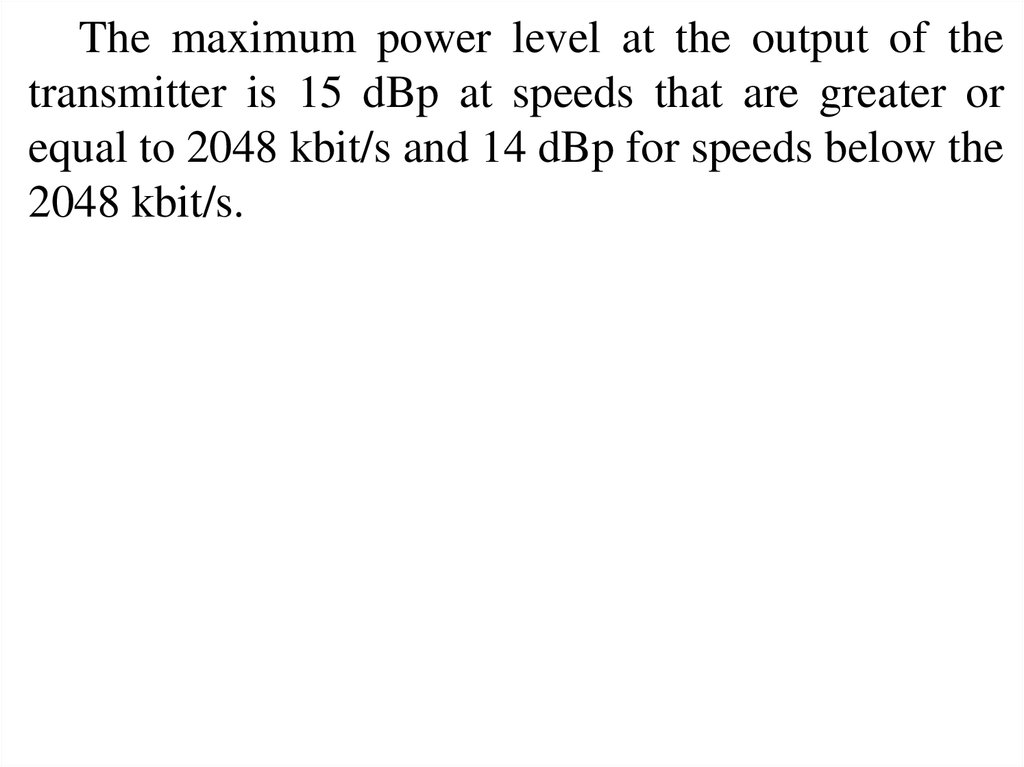Similar presentations:
Simmetrical dsl technologies. Lecture 5
1. Name of discipline: Transmission systems of access networks (TSAN) Lecturer - Oreshkov Vasiliy Ivanovich
2.
Lecture 5SIMMETRICAL DSL
TECHNOLOGIES
3.
Main terms and usage specificationsBasic version of the SHDSL (Single-pair Highspeed Digital Subscriber Line – Recommendation
ITU-T G.991.2) transmission system (TS) uses 16level pulse amplitude modulation (PAM) with trellis
coded – 16-TCPAM.
Using the trellis codes provide gain in 5 dB, thus
reducing the error probability for transmission and
increase the distance of communication. For
decoding at the receiver using Viterbi algorithm is
effective.
4.
Additional gain in SHDSL TS gained through theuse Tomlinson precoding – signal precoding at the
transmitter based on knowledge of the channel
impulse response.
As a result of the application of these algorithms
SHDSL, compared with single-pair variant HDSL
TS (Recommendation ITU-T G.991.1), using code
2B1Q, as demonstrated by the operation, thus
increasing by 35 - 45% transfer rate for the same
distance or increase distance on 15 - 20% at the same
speed.
5.
In order to ensure the provision of services atdifferent levels in SHDSL TS lets you choose speeds
ranging from 192 kbit/s to 2312 kbit/s in steps of 8
kbit/s. In order to reduce the transfer rate resort in
cases where it is necessary to achieve an increase in
transmission distance, and the regenerators
installation is impossible or impractical. Length of
digital SL in the SHDSL TS is about 2 km for
maximum transfer rate (cable type ТП diameter
cores 0.4 mm), for minimal – more than 6 km.
6.
To increase the transfer rate of in SHDSL TS hasthe ability use to data transmission simultaneously
to four pairs, which allows to provide transfer rate
up to 9.248 Mbit/s.
Was put in the December 2003 edition of the
Recommendations G.991.2 provides SHDSL TS
option with the increased speed of information
transfer one pair cable to 5696 kbit/s, with possible
use as a modulation of 16-TCPAM, and 32-TCPAM.
This allows SHDSL TS for work in four paired
transmission mode reach rates of 22784 kbit/s.
In 2007 there were reports of further increasing
the maximum transfer rate of one pair SHDSL TS to
15200 kbit/s by implementing 64-TCPAM and 128TCPAM modulation techniques.
7.
Frame structure of SHDSLThe largest element of the SHDSL signal structure
is frame that consists of 4 blocks of useful data and
service information (see. Fig. 5.1).
Fig. 5.1
8.
Each data block contains 12 sub-blocks. Theduration of the frame when the synchronous
transmission mode is 6 ms, and if plesyochronous
mode– 6 + 3/(k + 12) ms, where k – is the size of
each block of useful information, k = 12(i + 8n)
bits. Information transfer rate is 64n + 8i kbit/s,
where 3 n 36 and 0 i 7. For n = 36 i can
take only two values: 0 and 1 The information
transfer rate is set during initialization.
9.
Block diagram of the SHDSL transmitterThe block diagram of the transmitter STU-C
(SHDSL Transceiver Unit at the Central Office) or
STU-R (SHDSL Transceiver Unit at the Remote
End) is shown in Fig. 5.2.
Sinf
s(n)
Sserv
Ssync
Multiplexer
f(n)
Scrambler
x(m)
TCM
coder
y(m)
Precoder
z(t)
Spectrum
shaper
to SL
interface
output
Fig. 5.2
10.
The input multiplexer combines the informationSinf and service Sserv signal with synchronization and
control signals Ssync into a single digital stream f(n), n
= 1, 2, …, (n number of bits) according to the
frame structure of the signal.
Formed digital stream is scrambling, and
pseudorandom signal s(n), n = 1, 2, …, the input of
the encoder TCM (Trellis Coded Modulation).
Output signals TCM-encoder is K-bit information
symbols x(m), m = 1, 2, … (m number of
symbols).
11.
Then the symbols x(m) lists the Tomlinsonprecoding algorithm in symbols y(m), m = 1, 2, …,
and come in a spectrum shaper that provides a
digital signal y(m) to analog signal z(t) to the desired
spectral characteristics.
According to transferring K information bits per
symbol duration PAM-symbol in K times greater
than length of the bit.
Symbol rate fsym (symbol/s) related to the rate of
transmission of useful information R (bit/s) the
following relation:
fsym = (R + 8) / 3.
12.
SHDSL signal power spectral density(PSD) masks
Spectrum shaper device creates the output signal
power spectral density (PSD) masks which satisfies
power shown in Fig. 5.3-5.4. One of the features of
SHDSL TS is that the width of the spectrum of
transmitted signal is proportional to the speed of
information transfer.
In SHDSL TS assumed optional use of
asymmetric (different to the station and subscriber
side) PSD masks.
13.
Fig. 5.3 SHDSL PSD masks for bitrates: 256; 512; 768; 1536; 2048and 2304 kbit/s (16-TCPAM)
14.
Fig. 5.4 SHDSL PSD masks for bitrates: 3848 kbit/s(16-TCPAM) і 5696 kbit/s (32-TCPAM)
15.
The maximum power level at the output of thetransmitter is 15 dBp at speeds that are greater or
equal to 2048 kbit/s and 14 dBp for speeds below the
2048 kbit/s.















 internet
internet informatics
informatics








